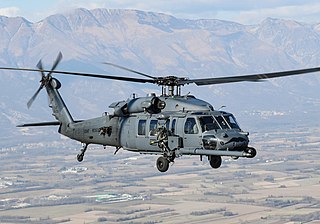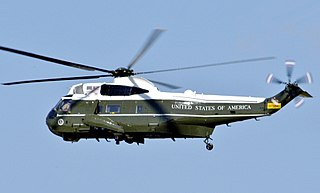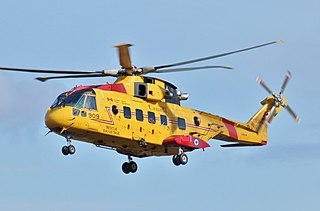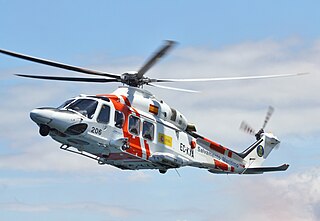
The Sikorsky UH-60 Black Hawk is a four-blade, twin-engine, medium-lift utility military helicopter manufactured by Sikorsky Aircraft. Sikorsky submitted the S-70 design for the United States Army's Utility Tactical Transport Aircraft System (UTTAS) competition in 1972. The Army designated the prototype as the YUH-60A and selected the Black Hawk as the winner of the program in 1976, after a fly-off competition with the Boeing Vertol YUH-61.

The Sikorsky MH-60/HH-60 Pave Hawk is a four-blade, twin-engine, medium-lift utility military helicopter manufactured by Sikorsky Aircraft. The HH-60 Pave Hawk and its successor the HH-60W Jolly Green II are combat rescue helicopters, though in practice they often serve humanitarian and peacetime disaster rescue. It is a derivative of the UH-60 Black Hawk and incorporates the US Air Force PAVE electronic systems program. The HH-60/MH-60 is a member of the Sikorsky S-70 family.

The Sikorsky SH-3 Sea King is an American twin-engined anti-submarine warfare (ASW) helicopter designed and built by Sikorsky Aircraft. A landmark design, it was one of the first ASW rotorcraft to use turboshaft engines.

The Sikorsky SH-60/MH-60 Seahawk is a twin turboshaft engine, multi-mission United States Navy helicopter based on the United States Army UH-60 Black Hawk and a member of the Sikorsky S-70 family. The most significant modifications are the folding main rotor blades and a hinged tail to reduce its footprint aboard ships.
Sikorsky Aircraft is an American aircraft manufacturer based in Stratford, Connecticut. It was established by aviation pioneer Igor Sikorsky in 1923, and was among the first companies to manufacture helicopters for civilian and military use. It also produced seaplanes for passenger transport and surface vehicles such as trains and boats.

Marine One is the call sign of any United States Marine Corps aircraft carrying the president of the United States. It usually denotes a helicopter operated by Marine Helicopter Squadron One (HMX-1) "Nighthawks", consisting of either the large Sikorsky VH-3D Sea King or the newer, smaller VH-60N "White Hawk". Both helicopters are called "White Tops" because of their livery. Any Marine Corps aircraft carrying the vice president of the United States without the president has the call sign Marine Two.

The AgustaWestland AW101 is a medium-lift helicopter in military and civil use. First flown in 1987, it was developed by a joint venture between Westland Helicopters in the United Kingdom and Agusta in Italy in response to national requirements for a modern naval utility helicopter. Several operators, including the armed forces of Britain, Denmark, and Portugal, use the name Merlin for their AW101 aircraft. It is manufactured at factories in Yeovil, England, and Vergiate, Italy. Licensed assembly work has also taken place in Japan and the United States.

The AgustaWestland CH-149 Cormorant is the Canadian Forces designation for the AgustaWestland AW101, a helicopter used for air-sea rescue in Canada. Developed from AgustaWestland in Italy, the CH-149 is a medium-lift helicopter for military applications.

AgustaWestland was an Anglo-Italian helicopter design and manufacturing company, which was a wholly owned subsidiary of Finmeccanica. It was formed in July 2000 as an Anglo-Italian multinational company, when Finmeccanica and GKN merged their respective helicopter subsidiaries to form AgustaWestland, with each holding a 50% share. Finmeccanica acquired GKN's stake in AgustaWestland in 2004.

Marine Helicopter Squadron One (HMX-1) is a United States Marine Corps helicopter squadron responsible for the transportation of the president and vice president of the United States, heads of state, Department of Defense officials, and other VIPs as directed by the Marine Corps and White House Military Office. A Marine helicopter with the president aboard uses the call sign "Marine One". Previously, HMX-1 was also tasked with operational test and evaluation (OT&E). This task was reassigned to VMX-1 in Yuma, Arizona; since the contract award of the new presidential helicopter in 2014 to Sikorsky Aircraft, however, HMX-1 has assumed the temporary role of OT&E for this platform, because of its unique nature and mission. The VH-92A first flew in 2017 and is expected to be operational sometime after 2022. Nicknamed "Nighthawks", HMX-1 is headquartered at Marine Corps Air Facility Quantico, Virginia, and maintains detachments at Joint Base Anacostia–Bolling in Washington, D.C., and Joint Base Andrews Naval Air Facility in Maryland.

The Sikorsky S-92 is an American twin-engine medium-lift helicopter built by Sikorsky Aircraft for the civil and military helicopter markets. The S-92 was developed from the Sikorsky S-70 helicopter and has similar parts such as flight control and rotor systems.

The Lockheed Martin VH-71 Kestrel was a variant of the AgustaWestland AW101 that was being manufactured to replace the United States Marine Corps' Marine One U.S. Presidential transport fleet. Originally marketed for various competitions as the US101, it was developed and manufactured in the US by a consortium headed by Lockheed Martin, consisting of Lockheed Martin Systems Integration – Owego (LMSI), AgustaWestland and Bell Helicopter.

The AgustaWestland AW139, now known as the Leonardo AW139, is a 15-seat medium-sized twin-engined helicopter developed and produced by the Anglo-Italian helicopter manufacturer AgustaWestland, now part of Leonardo. It is marketed at several different roles, including VIP/corporate transport, military use, offshore transport, firefighting, law enforcement, search and rescue, emergency medical service, disaster relief, and maritime patrol.
Lockheed Martin Systems Integration – Owego (LMSI) was a subsidiary of Lockheed Martin, in the Electronic Systems sector, located in Owego, New York, with approximately 2,500 employees. It used to be known as Lockheed Martin Federal Systems.

The General Electric T700 and CT7 are a family of turboshaft and turboprop engines in the 1,500–3,000 shp (1,100–2,200 kW) class.
The Armed Aerial Scout (AAS) was the planned replacement for the OH-58 Kiowa in United States Army service. This program resulted after the Armed Reconnaissance Helicopter resulted in selection of the Bell ARH-70 Arapaho, but was ultimately not procured due to financial and other reasons, and the AAS program itself did result in a new design procurement. The next program lead to the Future Attack Reconnaissance Aircraft, which was also halted before procurement. Meanwhile the OH-58 was retired by the 2020s, leaving the Army to fill the gap with other types of aircraft and systems.

Future Vertical Lift (FVL) is a plan to develop a family of military helicopters for the United States Armed Forces. Five different sizes of aircraft are to be developed, sharing common hardware such as sensors, avionics, engines, and countermeasures. The U.S. Army has been considering the program since 2004. FVL is meant to develop replacements for the Army's UH-60 Black Hawk, AH-64 Apache, CH-47 Chinook, and OH-58 Kiowa helicopters. The precursor for FVL is the Joint Multi-Role (JMR) helicopter program.
The Italian Armed Forces aircraft designation system is a unified designation system introduced by the Italian Armed Forces in 2009 for all Italian military aircraft. The system is based on the United States Armed Forces 1962 United States Tri-Service aircraft designation system.

The Sikorsky/Lockheed Martin VH-92 Patriot is an American helicopter under development to replace the United States Marine Corps' Marine One U.S. presidential transport fleet. It is a militarized variant of the Sikorsky S-92 and is larger than the current Marine One helicopters.

















